MechSE’s Feng Uses Bubbles to Teach Fluids Principles, Pique Students’ Interest in STEM
If good people who know a concept well don't pass that knowledge on to the next generation, then that knowledge could be lost. – Jie Feng’s Princeton PhD advisor, Professor Howard Stone
August 9, 2019
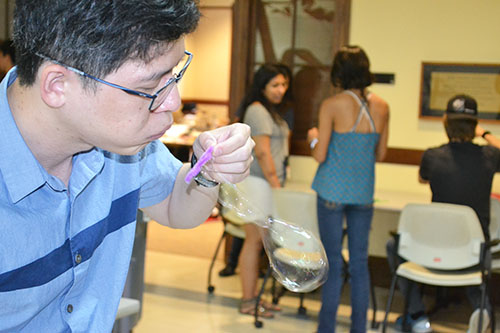
MechSE Assistant Professor Jie Feng demonstrates principles about bubbles for high school students at WYSE camp.
The above paradigm, which (Mechanical Science and Engineering (MechSE) Assistant Professor Jie Feng picked up from his Princeton Ph.D. advisor, has helped to fuel his love of STEM education outreach. So, lest some of his knowledge about bubbles be lost, this summer, Feng and some assistants, including Adriana Coariti, an Assistant Project Coordinator and Research Scholar at NCSA's Nano Manufacturing Node, shared concepts about his research with some young people. The students ranged in ages from high schoolers participating in the MechSE portion of the WYSE (Worldwide Youth in Science and Engineering) camp on July 12, down to early primary school students at the Creative Science Camp of the Orpheum Children’s Science Museum on July 15th.
As children, most of us probably recall whiling away the summer playing with those little colored plastic bottles of bubbles with a wand inside—and the magic of blowing through the wand to see how many bubbles or how big of a bubble we could create. However, Feng has taken the bubble-making experience to a whole new level. In the activities he and Adriana Coariti developed for the two outreach sessions, he encouraged kids to create non-spherical bubbles—the shape of these were to be determined by tension in a confinement area.

Left to right: Adriana Coariti and Jie Feng show a boy at the Orpheum how to make a bubble wand.
So in the activities, participants created various-shaped “wands” using materials such as pipe cleaners and straws to see if they could force the bubbles to change from their normal round or spherical shape to a different shape, such as a rectangle or square. He also had them try to create 3D-shaped bubbles by inserting smaller bubbles into larger ones.
Can something so fun and entertaining for youngsters teach them about science? You bet. One of the main themes of Feng’s research in his Fluids, Interfaces, & Nano-Therapeutics Laboratory is bubble dynamics. His research as a whole focuses on understanding fundamental interfacial phenomena in structured fluids and interfaces. His goal is to derive new insights for softer materials engineering in order to solve problems in the environment and human health.
For example, he studies the fate of bubbles in nature, such as in an oil spill or layers of organic materials on the ocean.
“So, for instance, I tried to study how that bubble will be formed in the ocean and how the bubble dynamics will affect the distribution of the oil spill in nature.”
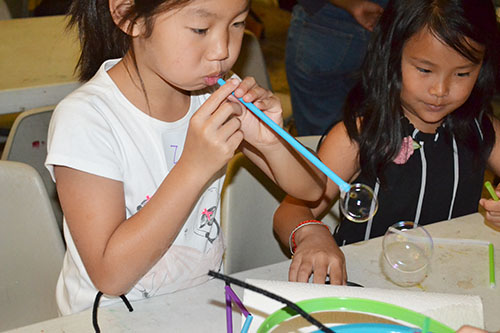
A youngster at the Orpheum employs a straw to blow some bubbles.
So, is there any way bubbles could actually be used to help clean up an oil spill? Feng says yes. “Some naturally-existing phenomena might help to degrade the oil spills more easily.” He reports that the bubble will first flow to the interface. Next, “If you remember from daily life,” he continues, “the bubble will disappear. Actually this disappearing includes rich hydrodynamic phenomena, and these hydrodynamics will disperse the oil spill as very tiny droplets in the air and also in the water column.”
According to Feng, this dispersal has both a good and a bad side. The bad side is that, of course, by making the oil into tiny droplets, it’s easier for it to spread because it’s smaller. On the flip side, though, if by using bubbles, the thick oil layer can be dispersed into very tiny droplets, then natural creatures like bacteria can more easily digest the small droplets.
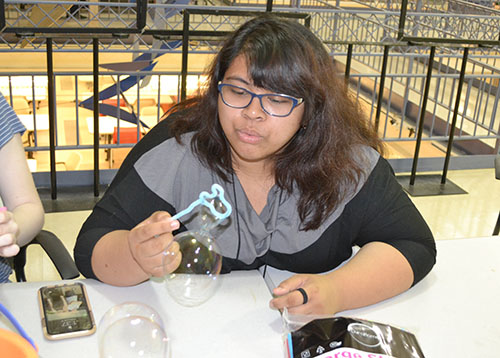
A high school student in WYSE camp blows a bubble using the unique-shaped wand she designed.
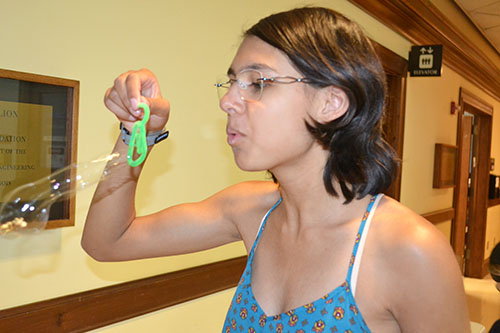
A high schooler in WYSE blows bubbles through the wand she designed.
“So, one possible way to reduce the disadvantage of the oil spill is…to create a lot of bubbles in a certain area so that you actually make all this thick oil spill into very, very, tiny droplets. For the same volume, the tiny droplet will have more surface area for the bacteria to help eliminate the oil spill.”
Feng, who began at Illinois in January 2019 says one of his goals for down the road is to submit a proposal for an NSF Career Grant, possibly next year. As part of the proposal, he’ll need to submit a plan for the required outreach component. Though he says he doesn’t have a “super Career idea” right now, his goal is to start preparing by getting more involved with outreach to get a sense of various activities that might work with high school and primary school kids.
But even if outreach weren’t connected to a possible NSF grant, he’d still be doing it. “Deep in my mind,” he acknowledges, “I was actually inspired by my PhD advisor, Professor Howard Stone at Princeton University. He's very passionate about outreach.”
In fact, Feng still remembers a comment Howard Stone made when he first joined his group: “If good people who know a concept well don't pass that knowledge on to the next generation, then that knowledge could be lost.”
Feng says the philosophy that Howard Stone modeled has triggered a desire in him to devote time to outreach about his research: “I mean, bubbles are ubiquitous,” he says. “But people seldom really think, what's behind it, how to manipulate the shape of the bubbles, and the beauty of surface tension.” Since it’s so closely related to his research, he admits, “I'm just wanting to explain more to the youth.”
He also says doing these outreach activities is helping him to better communicate about his research—to bring those high-level concepts down into language that high schoolers, even six-year-old kids can understand. “It also helped me to introduce my research better, because it's not easy to express some concepts to those young kids,—to educate people about the science behind these beautiful bubbles.”

A high schooler takes a photo of the unique bubble her structure made (see below).
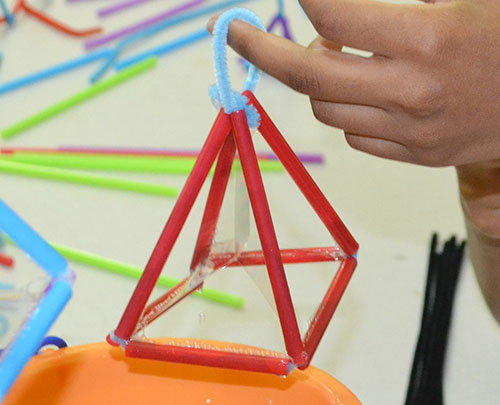
Regarding the impact he hopes the outreach had on the high schoolers, Feng explains that first, he sought to introduce the students to his personal journey into science and engineering, which might be relevant to their own experiences. With regard to the science itself, he says, “I think it's important for them to build up a concept, ‘What is happening behind this phenomena?’” He hopes the activity will cause the students to think about what's behind other everyday phenomena when they see them—to not just take them for granted.
He also hopes his activity might “encourage the students to ask questions…because we always see bubbles.” Feng believes it’s crucial that young people develop the practice of asking questions: “I think it’s an important mindset for a lot of scientists and engineers. I think they should train themselves to ask questions…So I hope my activity can make some impact on the kids that they can really extract the knowledge. They can begin to ask questions about the everyday things that they see, and then to build up the mindsets of being a scientist or an engineer.”
What impact does Feng hope the activity had on the youngsters at the Orpheum? For these kids, he hopes they had fun playing with the bubbles. “I mean, they are small kids,” he admits. “So most importantly, I just I hope they had some fun in these engineering-related problems.” He admits that he didn't really try to explain to them a lot of things they can do with bubbles, especially in regards to solving practical problems, or all about using the 3D shapes. His goal is to convey that bubbles “can be beautiful. I mean, you can get nice images and, you can do a lot of very interesting things.”
He not only hoped that the young kids would have some fun playing with structures and engineering concepts and appreciate their beauty, but he hoped that sometime in the future, while participating in a similar activity, they’ll recall this event and be able to build on what they learned through his activity. “They spend a meaningful day,” he adds, “and then after maybe dozens of years, they see a structure or maybe they learn more things about surface tension in college.” He’s hopeful that it might be while they're studying mechanical engineering, that they “remember the concept and maybe go deeper into that actually. You can take that kind of concept to make complicated structures.”
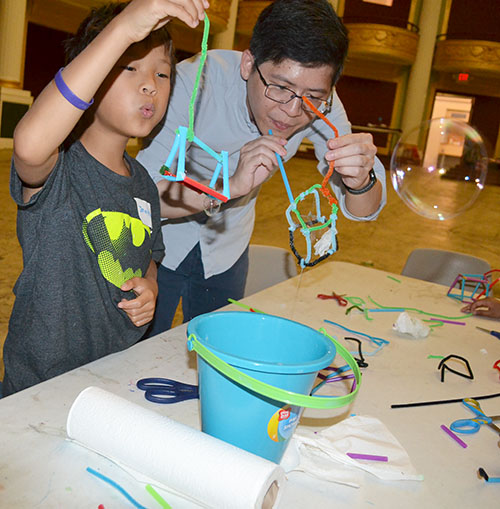
Jie Feng (right) and a boy at the Orpheum outreach blow bubbles throught the 3D wands they created.
Feng adds that these kinds of outreach activities are basically just to encourage young people to devote more time and energy to science and engineering, and says both the professors at Illinois and the MechSE department are very supportive of that.
“So we have a lot of opportunities to educate the next generation about our research,” he continues. “I think it's important for us to find a way to connect kids with these complicated, high-level concepts—with intuitive and also interesting research.”
He also adds that he wishes that when he was young, some professor had done the same—“taught me about these beautiful concepts. I mean, I didn't get a chance for that.” So now Feng wants to be that person for some of today’s kids.
“It's really fun to interact with the kids, and they ask all kinds of questions, and hopefully, it also helps them to learn something a little bit.”
Author/Photographer: Elizabeth Innes, Communications Specialist, I-STEM Education Initiative
More: K-6 Outreach, Faculty Feature, MechSE, 2019
For additional I-STEM web articles about MechSE faculty, see:
- Local Children “Make” Nanodiamond Molecules at the Orpheum Courtesy of MechSE Professor Lili Cai
- Mattia Gazzola’s Paper2Tree: A 3-Step Program to Give Back to Your Community: Publish a Paper ➜ Plant a Tree ➜ Perform a School Outreach
- MechSE’s Joe Muskin Enlightens Local Youngsters About 3D Printing During Champaign Public Library Event
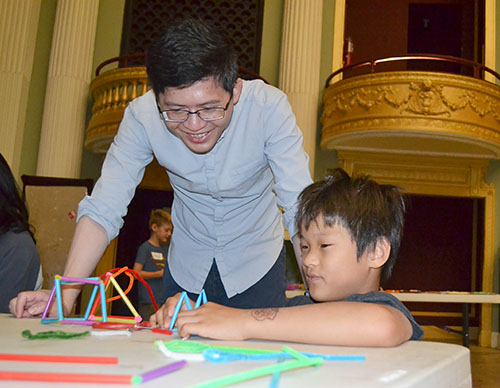
Jie Feng admires the structure of the bubble wands a young boy at the Orpheum designed.
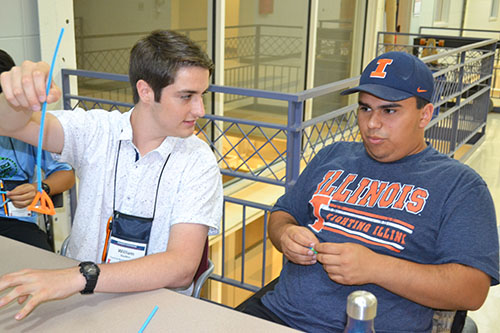
Two students at WYSE camp discuss the merits of the bubble wand one created.
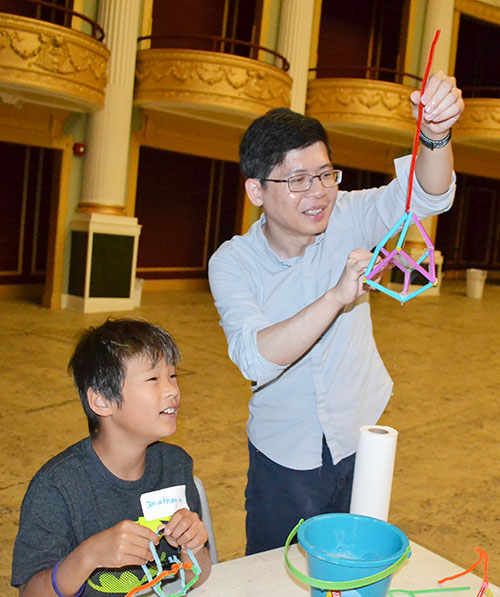
Jie Feng (right) and a boy at the Orpheum outreach appreciate the 3D wand Feng created.
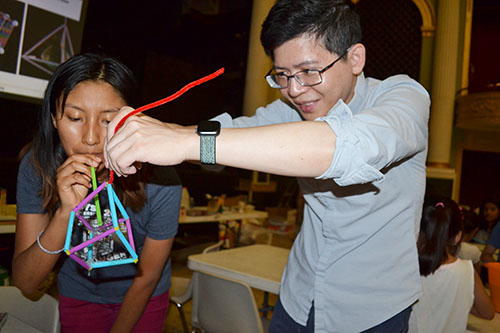
At the Orpheum, Adriana Coariti (left) uses a straw to blow a bubble inside a larger bubble Jie Feng created with the 3D wand he designed.
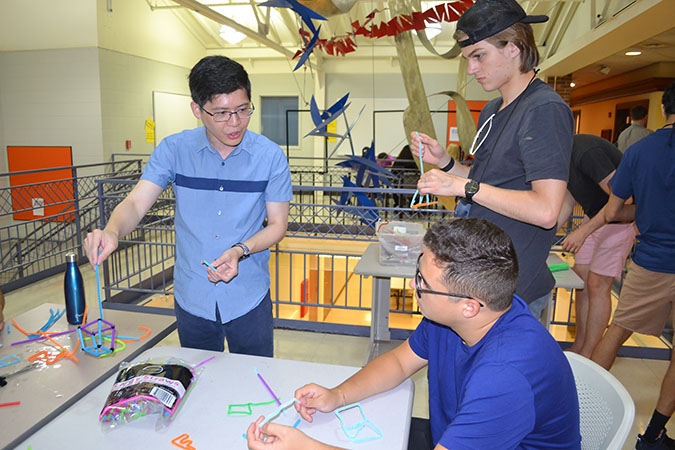
Jie Feng interacts with WYSE highschoolers about the 3D bubble wand he created.













.jpg)
















